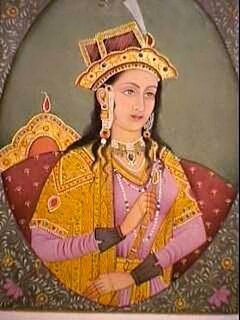Tukulti-Ninurta II was King of Assyria from 891 BC to 884 BC. He was the second king of the Neo Assyrian Empire.

Mariam-uz-Zamani, was a wife of the Mughal emperor Akbar. In subsequent centuries, she has been referred to with several other names, including Hira Kunwari, Harkha Bai and Jodha Bai.

The Sulamani Temple is a Buddhist temple located in the village of Minnanthu in Burma. The temple is one of the most-frequently visited in Bagan.

Begum Shahi Mosque, officially The Mosque ofMariyam Zamani Begum, is an early 17th-century mosque situated in the Walled City of Lahore, Punjab, Pakistan. The mosque was built between 1611 and 1614 during the reign of Mughal Emperor Jahangir in honour of his mother. It is Lahore's earliest surviving example of a Mughal-era mosque, and influenced construction of the larger Wazir Khan Mosque a few decades later. This mosque was turned in name of most celebrated Sikh hero Bhai Mani Singh ji, as Shaheed Ganj Bhai Mani Singh, under Sikh rule.

The Tomb of Mariam-uz-Zamani is the mausoleum of Mariam-uz-Zamani, the Queen consort of the Mughal Emperor Akbar. The tomb was built by Jahangir, in memory of his mother Mariam-uz-Zamani. The tomb is located in Sikandra, a suburb of Agra.

The Zamani Project is part of the African Cultural Heritage Sites and Landscapes Database. Zamani is a research group at the University of Cape Town, which acquires, models, presents and manages spatial and other data from cultural heritage sites. The present focus of the Zamani project is Africa, with the principal objective of developing “The African Cultural Heritage Sites and Landscapes Database”. Zamani comes from the Swahili phrase “Hapo zamani za kale” which means “Once upon a time”, and can be used to mean 'the past'. The word is derived from Arabic root for temporal vocabulary, ‘Zaman,’ and appears in several languages around the world.

Mostafa Zamani is an Iranian actor. He was born from Mazandrani father and Gilani mother at Gilan and he lived until 7 years old at Gilan and then he moved to Fereydunkenar Mazandaran Province.

Lotar is a village in Rudbar-e Mohammad-e Zamani Rural District, Alamut-e Gharbi District, Qazvin County, Qazvin Province, Iran. At the 2006 census, its population was 144, in 44 families.
Moradabad is a village in Rudbar-e Mohammad-e Zamani Rural District, Alamut-e Gharbi District, Qazvin County, Qazvin Province, Iran. At the 2006 census, its population was 25, in 12 families.

Garmak is a village in Rudbar-e Mohammad-e Zamani Rural District, Alamut-e Gharbi District, Qazvin County, Qazvin Province, Iran. At the 2006 census, its population was 77, in 20 families.
Shuwa-Zamani is a Kainji language of Nigeria.

Zamani is a village in Sedeh Rural District, Sedeh District, Qaen County, South Khorasan Province, Iran. At the 2006 census, its population was 122, in 52 families.

Hemmatabad-e Zamani is a village in Takht-e Jolgeh Rural District, in the Central District of Firuzeh County, Razavi Khorasan Province, Iran. At the 2006 census, its population was 1,447, in 390 families.

Qaleh-ye Juq Zamani is a village in Boghrati Rural District, Sardrud District, Razan County, Hamadan Province, Iran. At the 2006 census, its population was 471, in 106 families.

Khan Jamal-e Zamani is a village in Bavaleh Rural District, in the Central District of Sonqor County, Kermanshah Province, Iran. At the 2006 census, its population was 317, in 66 families.

Aghcheh Kohal-e Zamani is a village in Ujan-e Sharqi Rural District, Tekmeh Dash District, Bostanabad County, East Azerbaijan Province, Iran. At the 2006 census, its population was 119, in 22 families.

Fire of Zamani is the second studio album by Nigerian hip hop recording artist Ice Prince. It was released by Chocolate City on October 28, 2013. The album was executively produced by Audu Maikori, Paul Okeugo, Yahaya Maikori, and Jude Abaga. It was mastered by Sean Stan of Vintage Sounds Production. The album's production was primarily handled by Chopstix, a member of Grip Boiz City, along with additional production from Don Jazzy, Jay Sleek, Sammy Gyang, and E-Kelly. It features guest appearances from Sunny Neji, Wale, M.I, Chip, Ruby Gyang, Wizkid, French Montana, Jesse Jagz, Olamide, Sound Sultan, Burna Boy, Yung L, Jeremiah Gyang, Shaydee, and Morell. The album was supported by four singles—"Aboki", "More", "Gimme Dat", and "I Swear". It was marketed to East Africans by the distribution platform Mdundo.

Alireza Zamani is an Iranian arachnologist and taxonomist.
Zamani Zamri is a Singaporean footballer currently playing as a midfielder for Albirex Niigata Singapore.

Zamani Saul is a South African politician who is the 5th and current Premier of the Northern Cape and a Member of the Northern Cape Provincial Legislature. He has also been serving as the Provincial Chairperson of the African National Congress (ANC) since his election on 12 May 2017. He previously served as the Provincial Secretary and as the Deputy Provincial Secretary of the party.












